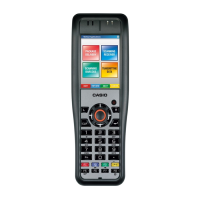97
2.4 USB
This chapter describes about detailed specifications of the USB.
2.4.1 Basic Specifications
Switching USB
• Switches between USB Client (USB Function) and USB Host.
• Switching between USB Client (USB Function) and USB Host is carried out by a signal from
the cradle. This cannot be performed in application.
• Switching is not possible while a USB device is connected to the cradle and the terminal is
recognizing the USB device. Switching can be performed once the USB device is
disconnected.
• USBIsHost API function can be used to capture the current USB Client (USB
Function)/Host status.
USB Client (USB Function)
• Supports the USB 1.1 full speed.
• Communicates with “wceusbsh.dll” on PC side.
• Communication with PC can be established via ActiveSync.
• Communication with PC can be established via FLCE/LMWIN (this case, ActiveSync must
be disabled.)
USB Host
• Supports the USB 1.1 full speed.
• Supports USB-MODEM/USB-LAN.
• USB device is disconnected when the terminal is suspended.
• Does not support WakeOn Ring/WakeOn LAN.
• Does not support communication via USB HUB.
USB-MODEM
• Supports the USB Communication Class (CDC: ACM).
• Communication with modem via virtual COM port can be established.
• Dial up via USB modem can be possible by selecting USB modem at the setting of connection
under Windows Embedded CE.
USB-LAN
• Supports the Ethernet Cradle.
• Can be connected to network via the TCP/IP protocol using the TCP/IP Wrapper Driver.

